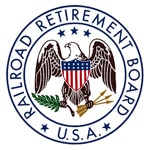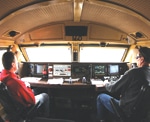
1. How are dual benefits paid to persons entitled to both railroad retirement and social security benefits?
Since 1975, if a railroad retirement annuitant is also awarded a social security benefit, the Social Security Administration determines the amount due, but a combined monthly dual benefit payment should, in most cases, be issued by the RRB after the railroad retirement annuity has been reduced for the social security benefit.
2. Why is a railroad retirement annuity reduced when a social security benefit is also payable?
The tier I portion of a railroad retirement annuity is based on both the railroad retirement and social security credits acquired by an employee and figured under social security formulas. It approximates what social security would pay if railroad work were covered by social security. Tier I benefits are, therefore, reduced by the amount of any actual social security benefit paid on the basis of nonrailroad employment, in order to prevent a duplication of benefits based on social security-covered earnings.
The tier I dual benefit reduction also applies to the annuity of an employee qualified for social security benefits on the earnings record of another person, such as a spouse. And, the tier I portion of a spouse or survivor annuity is reduced for any social security entitlement, even if the social security benefit is based on the spouse’s or survivor’s own earnings. These reductions follow principles of social security law that, in effect, limit payment to the higher of any two or more benefits payable to an individual at one time. An annuitant is required to advise the RRB if any benefits are received directly from the Social Security Administration or if those benefits increase (other than for a cost-of living increase).
However, the tier II portion of a railroad retirement annuity is based on railroad service and earnings alone, is computed under a separate formula, and is not reduced for entitlement to a social security benefit.
3. Are there any exceptions to the railroad retirement annuity reduction for social security benefits?
No. However, if an employee qualified for dual benefits before 1975 and met certain vesting requirements, he or she can receive an additional annuity amount which offsets, in part, the dual benefit reduction. This additional amount, which reflects the dual benefits payable prior to 1975, is called a vested dual benefit payment. Legislation enacted in 1974 coordinated dual railroad retirement and social security benefit payments to eliminate certain duplications, but this legislation also included a grandfather provision to preserve the pre-1975 dual benefits of persons meeting certain vesting requirements by including vested dual benefit payments in their annuities.
Awards of these vested dual benefit amounts are now limited only to vested railroad employees with dual coverage on their own earnings. Spouses and widow(er)s retiring since 1981 no longer qualify. Fewer than ten vested dual benefits were awarded in fiscal year 2013.
4. Are there any funding limitations on the payment of vested dual benefits?
Vested dual benefit payments are funded by annual appropriations from general U.S. Treasury revenues. These appropriations account for less than one percent of total financing sources for the railroad retirement system. Payment of vested dual benefits is dependent on the time and amount of such appropriations. If the appropriation in a fiscal year is for less than the estimated total vested dual benefit payments, individual payments must be reduced.
5. Can Federal, State, or local government pensions also result in dual benefit reductions in a railroad retirement annuity?
Tier I benefits for employees first eligible for a railroad retirement annuity and a Federal, State or local government pension after 1985 may be reduced for receipt of a public pension based, in part or in whole, on employment not covered by social security or railroad retirement after 1956. This may also apply to certain other payments not covered by railroad retirement or social security, such as from a non-profit organization or from a foreign government or a foreign employer. Usually, an employee’s tier I benefit will not be reduced by more than 1/2 of his or her pension from noncovered employment. However, if the employee is under age 65 and receiving a disability annuity, the tier I benefit may be reduced by an added amount if the pension from noncovered employment is a public disability benefit.
Military service pensions, payments by the Department of Veterans Affairs, or certain benefits payable by a foreign government as a result of a totalization agreement between that government and the United States will not cause a reduction.
6. How does the public service pension apply to spouse or widow(er)s’ benefits?
The tier I portion of a spouse’s or widow(er)’s annuity may be reduced for receipt of any Federal, State or local government pension separately payable to the spouse or widow(er) based on her or his own earnings. The reduction generally does not apply if the employment on which the public service pension is based was covered under the Social Security Act throughout the last 60 months of public employment. Most military service pensions and payments from the Department of Veterans Affairs will not cause a reduction. Pensions paid by a foreign government or interstate instrumentality will also not cause a reduction. For spouses and widow(er)s subject to a public service pension reduction, the tier I reduction is equal to 2/3 of the amount of the public service pension.
7. What dual benefit restrictions apply when both a husband and wife are rail employees entitled to railroad retirement annuities?
If both the employee and spouse are railroad employees and either had some railroad service before 1975, the spouse tier I amount is reduced by the amount of the railroad employee tier I to which the spouse is entitled and that initial reduction is restored in the spouse tier II amount. The spouse tier I amount cannot be reduced below zero.
If both the employee and spouse started railroad employment after 1974, the amount of any spouse or divorced spouse annuity is reduced by the amount of the employee annuity to which the spouse is also entitled.
In survivor cases, if a widow or dependent widower is also a railroad employee annuitant, and either the widow(er) or the deceased employee had 120 months of railroad service before 1975, the tier I reduction may be partially restored in the survivor tier II amount.
If either the deceased employee or the widow(er) had some railroad service before 1975 but less than 120 months of service, the widow(er)’s own employee annuity and the tier II portion of the survivor annuity would be payable to the widow(er). The tier I portion of the survivor annuity would be payable only to the extent that it exceeds the tier I portion of the widow(er)’s own employee annuity.
If the widow(er) is entitled to a railroad retirement employee annuity and neither the widow(er) nor the deceased employee had any railroad service befo
re 1975, the survivor annuity (tier I and tier II) payable to the widow(er) is reduced by the total amount of the widow(er)’s own employee annuity.
8. Can workers’ compensation or public disability benefits affect railroad retirement benefits?
If an employee is receiving a railroad retirement disability annuity, tier I benefits for the employee and spouse may, under certain circumstances, be reduced for receipt of workers’ compensation or public disability benefits.
9. How can an annuitant find out if receipt of any dual benefits might affect his or her railroad retirement annuity?
If an annuitant becomes entitled to any of the previously discussed dual benefit payments, or if there is any question as to whether a dual benefit payment requires a reduction in an annuity, he or she should contact an RRB field office by calling toll-free at (877) 772-5772. Annuitants can find the address of the RRB office serving their area by calling this number or by visiting www.rrb.gov. Most RRB offices are open to the public from 9 a.m. to 3:30 p.m., Monday through Friday, except on federal holidays.
 UTU members and their dependents insured under the Railroad Employees National Early Retirement Major Medical Benefit (ERMA) Plan (GA-46000) will have their lifetime maximum amount of coverage increased, effective Jan. 1.
UTU members and their dependents insured under the Railroad Employees National Early Retirement Major Medical Benefit (ERMA) Plan (GA-46000) will have their lifetime maximum amount of coverage increased, effective Jan. 1. WASHINGTON – The Association of American Railroads Nov. 21 issued the following statement from President and CEO Edward R. Hamberger in response to the Senate Commerce Committee staff report Update on the Financial State of the Class I Freight Rail Industry.
WASHINGTON – The Association of American Railroads Nov. 21 issued the following statement from President and CEO Edward R. Hamberger in response to the Senate Commerce Committee staff report Update on the Financial State of the Class I Freight Rail Industry. New tour buses and buses that provide service between cities must be equipped with seat belts starting in late 2016 under a federal rule issued Wednesday, a safety measure sought by accident investigators for nearly a half century.
New tour buses and buses that provide service between cities must be equipped with seat belts starting in late 2016 under a federal rule issued Wednesday, a safety measure sought by accident investigators for nearly a half century.
 Members of the SMART Transportation Division and all of rail labor have the opportunity to make it federal law to have two qualified persons working on all freight trains operating in the United States a reality.
Members of the SMART Transportation Division and all of rail labor have the opportunity to make it federal law to have two qualified persons working on all freight trains operating in the United States a reality. After Volkswagen issued a letter in September saying the company would not oppose an attempt by the United Auto Workers (UAW) to unionize its 1,600-worker Chattanooga, Tenn., facility, Sen. Bob Corker (R-Tenn.) was flabbergasted.
After Volkswagen issued a letter in September saying the company would not oppose an attempt by the United Auto Workers (UAW) to unionize its 1,600-worker Chattanooga, Tenn., facility, Sen. Bob Corker (R-Tenn.) was flabbergasted.